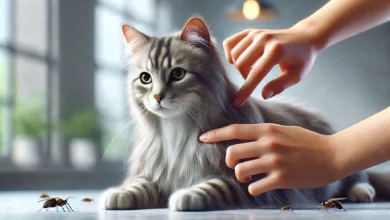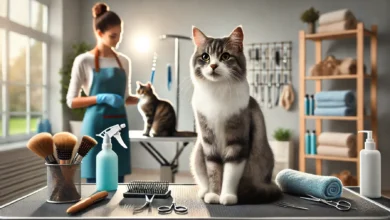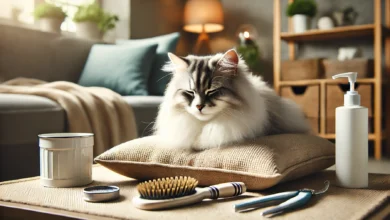How to Perform a Full Grooming Cat Session at Home
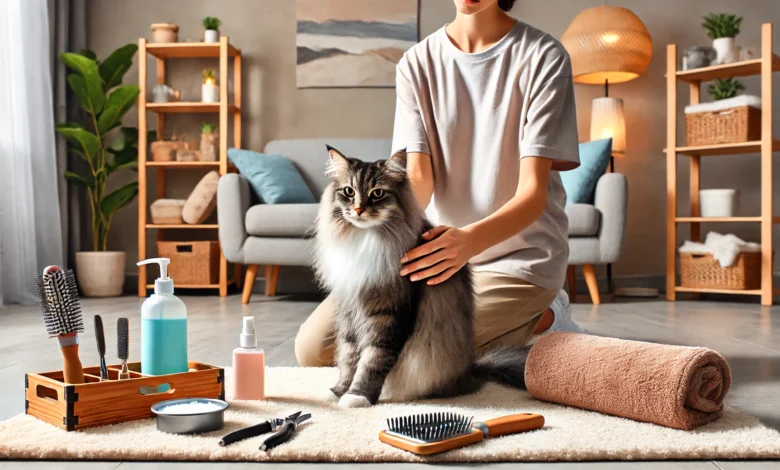
Grooming your cat in the comfort of your own home can be one of the best experiences you and your feline friend can share.
Not only does it help maintain hygiene and care for your cat’s coat, but it also brings you closer to your pet.
While full grooming might seem intimidating the first time around, with the right tools and a little bit of patience, you can easily make this process a smooth and enjoyable routine.
This guide will take you through every step of a full grooming session—from preparation right through to those finishing touches—so your cat stays healthy and happy.
Table of Contents
Preparing Your Cat and Grooming Tools for a Full Session
Preparation is the key to a successful full grooming session.
For those cats that do not particularly enjoy grooming, it is necessary to make sure that the environment is tranquil and all tools are prepared.
Cats are generally habitual animals, and any sudden change in environment could make them wary.
Therefore, taking your time with preparation really sets up a smoother full grooming experience.
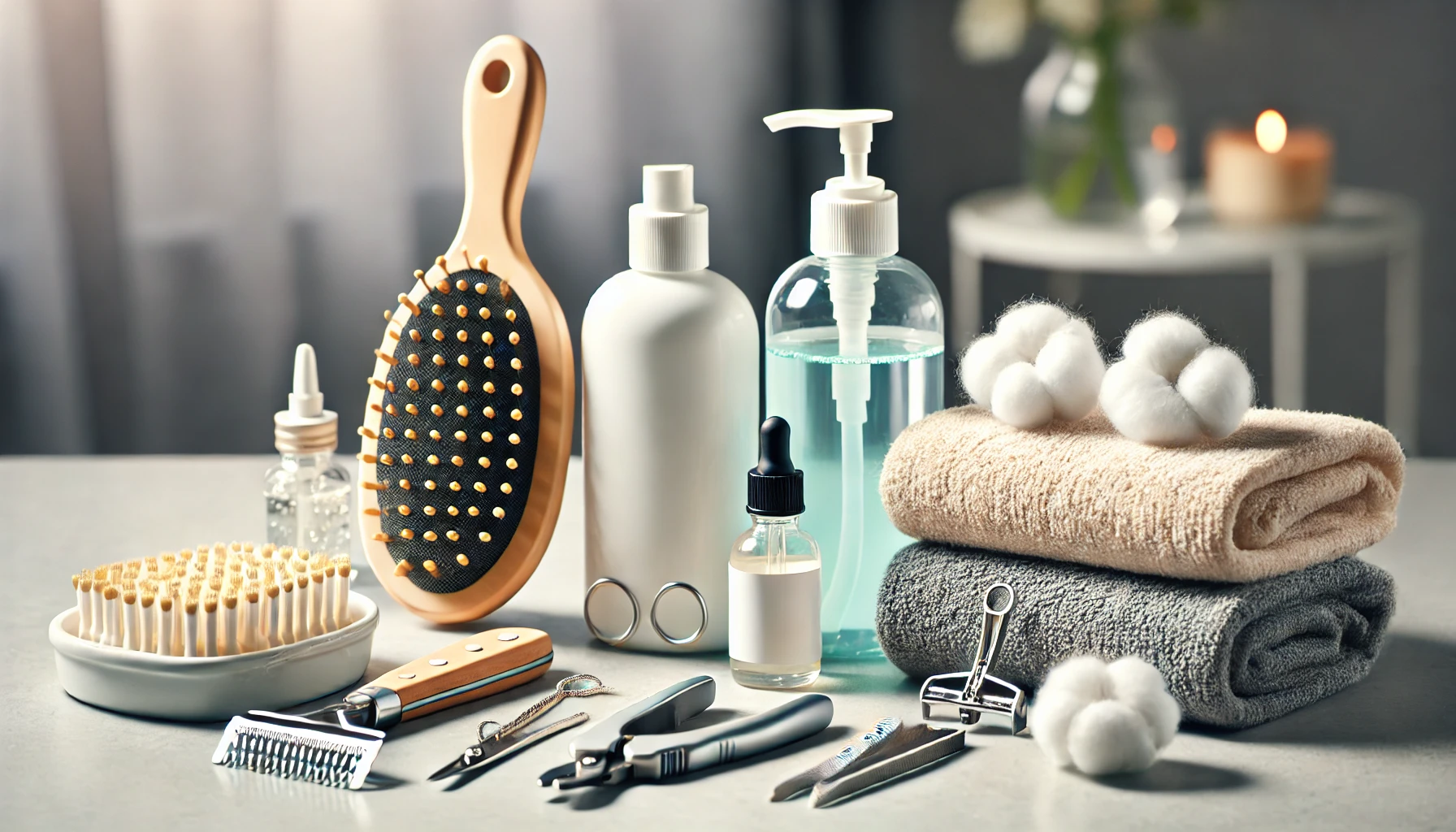
Gathering Essential Grooming Tools
Before you start, make sure you have the right equipment for the job.
Every cat is different to groom, due to their coat type, so you should alter your kit accordingly.
A standard full grooming kit should include:
- A brush or comb suitable for the type of coat your cat has: short-haired, long-haired, or curly
- Cat-safe shampoo for bathing
- Nail clippers designed for cats
- Ear cleaning solution and cotton balls
- A towel to dry your cat off with afterward
- Treats for rewarding your cat during and after the session
With all these tools prepared, you will be able to focus solely on your cat during the full grooming process and reduce the chances of having to stop in the middle of a session.
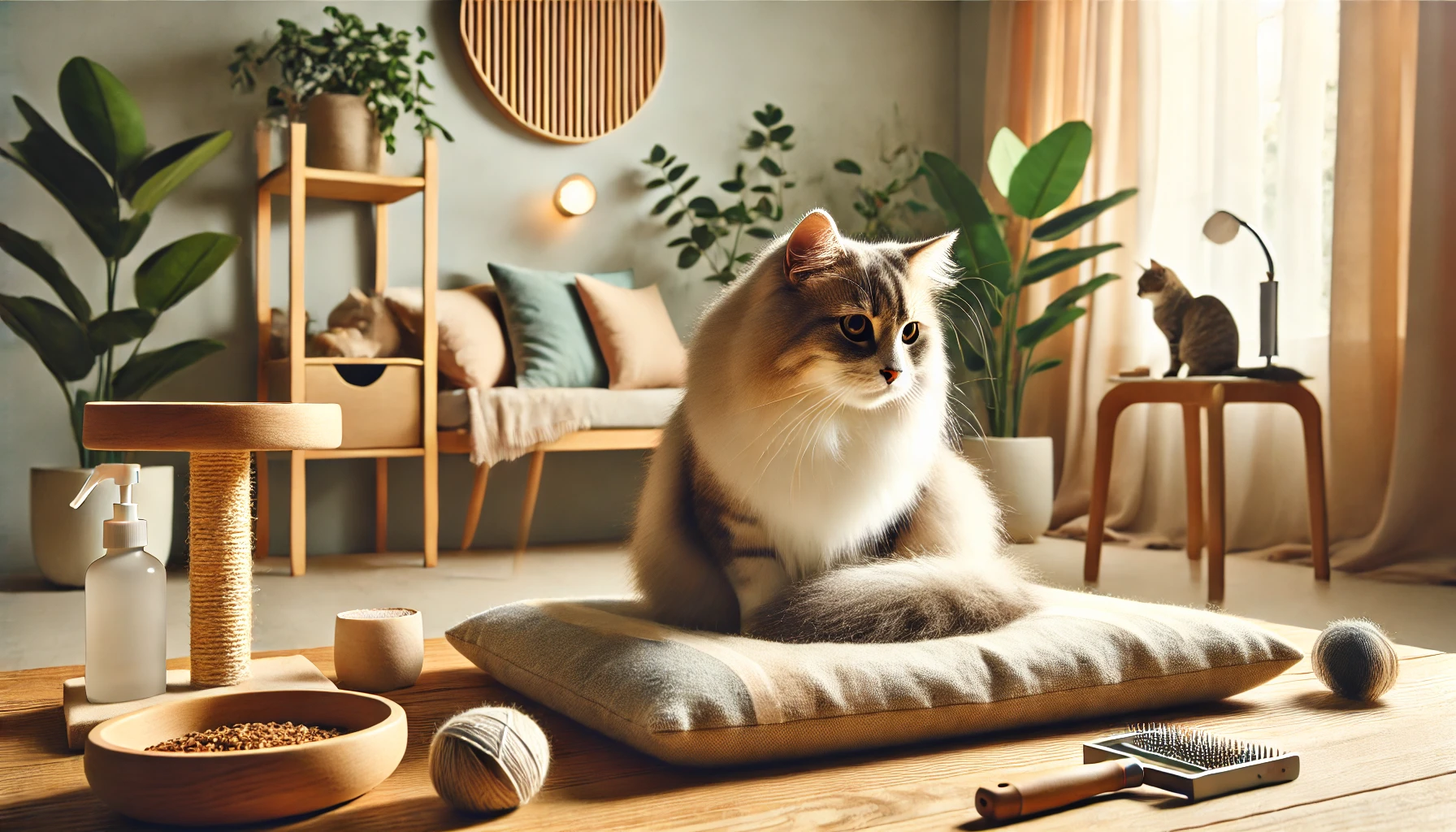
Creating a Relaxed Environment for Your Cat
First, provide a quiet place where your cat won’t be disturbed to make them feel safe and relaxed.
Cats are sensitive to their environment, so they don’t like loud noises or strange places.
Consider the following tips:
- Choose a room where your cat feels comfortable. It could be a bathroom or a very quiet corner in your house.
- Lay out a towel or a soft mat where your cat can sit or lie down.
- Keep the grooming tools nearby, yet out of view, since some cats may get apprehensive at the sight of certain tools.
- Spend several minutes petting and talking to your cat to help them relax before starting the full grooming session.
Setting up both your environment and your cat in advance will make the entire full grooming session much easier to manage.
Once your cat is comfortable and you have all of your equipment ready, it’s time to start the grooming process itself.
Preparation is key to ensuring a smooth and stress-free grooming session for your cat. A calm environment and the right tools can make all the difference in the success of the grooming process.
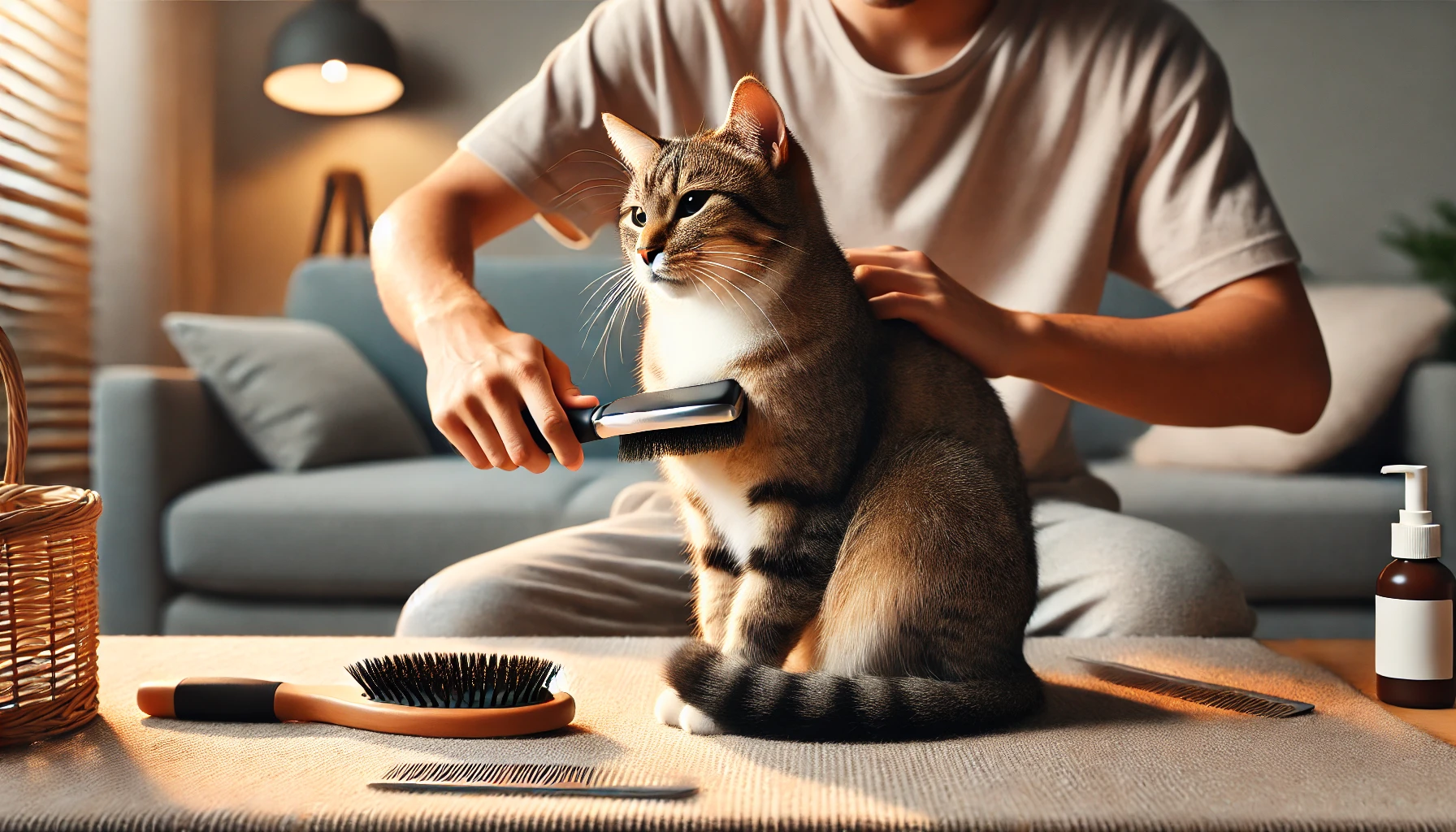
How to Brush and Detangle Your Cat’s Coat
Brushing forms a vital part of full grooming, whether your cat has a short-haired coat, medium-haired coat, or long-haired one.
Regular brushing eliminates loose hair that may cause matting and distributes the natural oils that keep your cat’s skin and coat healthy.
Depending on the length and type of fur your cat has, you will have to brush them more frequently or use specialized tools to groom effectively.
Here’s how you can go about the process of brushing and combing your cat to keep their fur sleek and shining.
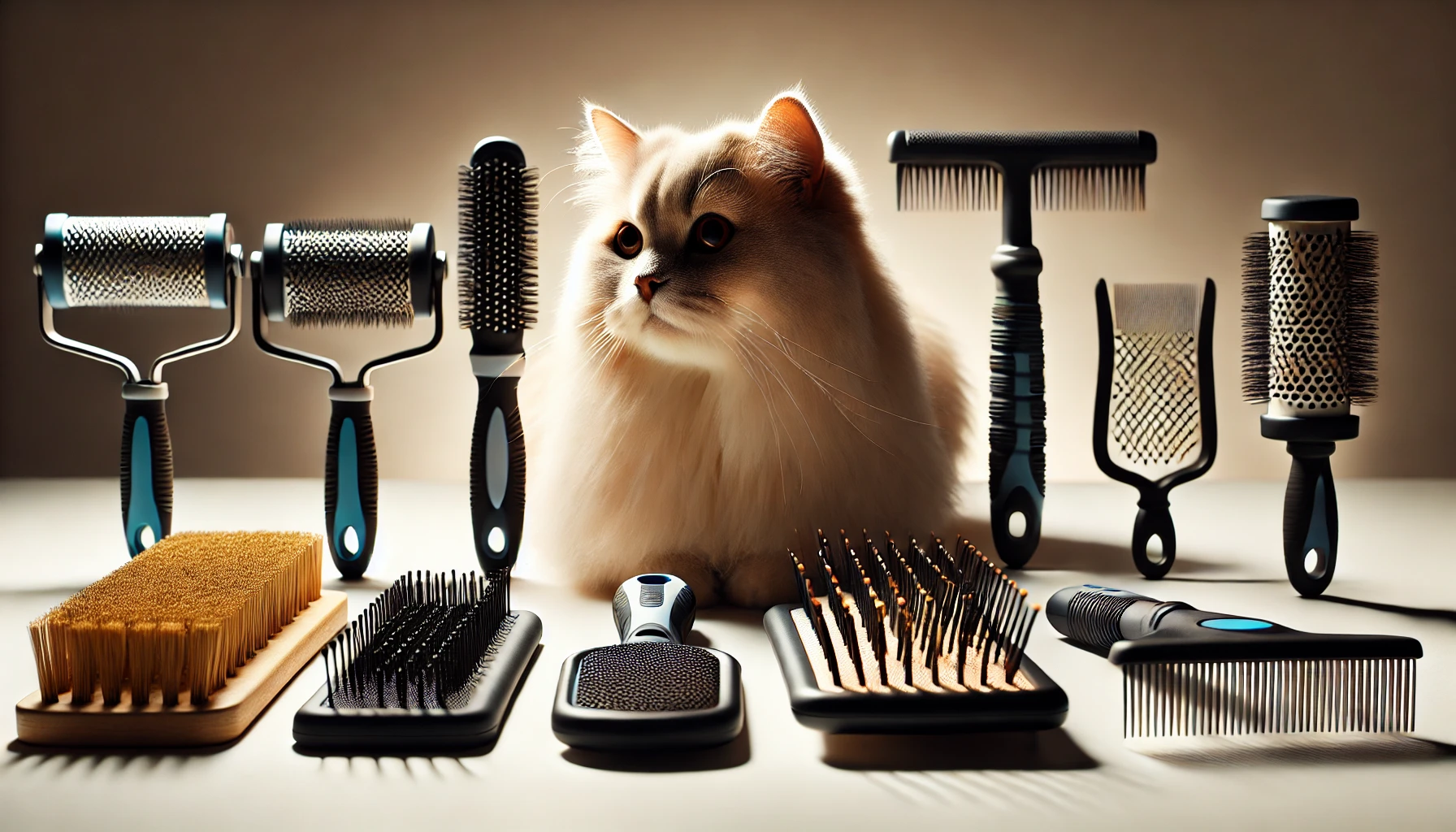
Selecting the Right Brush for Your Cat’s Coat
The grooming needs of cats vary depending on their coat type.
You should choose the best brush according to your cat’s coat.
Here are the best brushes for various types of cat coats:
- Slicker Brush: Ideal for long-haired cats, this brush removes loose fur and detangles knots.
- Bristle Brush: Good for short-haired cats, it smooths out the coat and removes dirt and loose fur.
- Wide-Tooth Comb: Ideal for cats with thick or curly coats, this comb detangles fur gently without pulling.
- De-shedding Tool: This tool helps remove the excess undercoat from cats that shed heavily, cutting down on shedding in your home.
It’s very important to be gentle with your cat when you brush them.
If your cat isn’t used to being brushed, always go slow and allow them to get used to the process.
Offering treats throughout brushing can help reinforce positive behavior and make the experience more enjoyable for both of you.
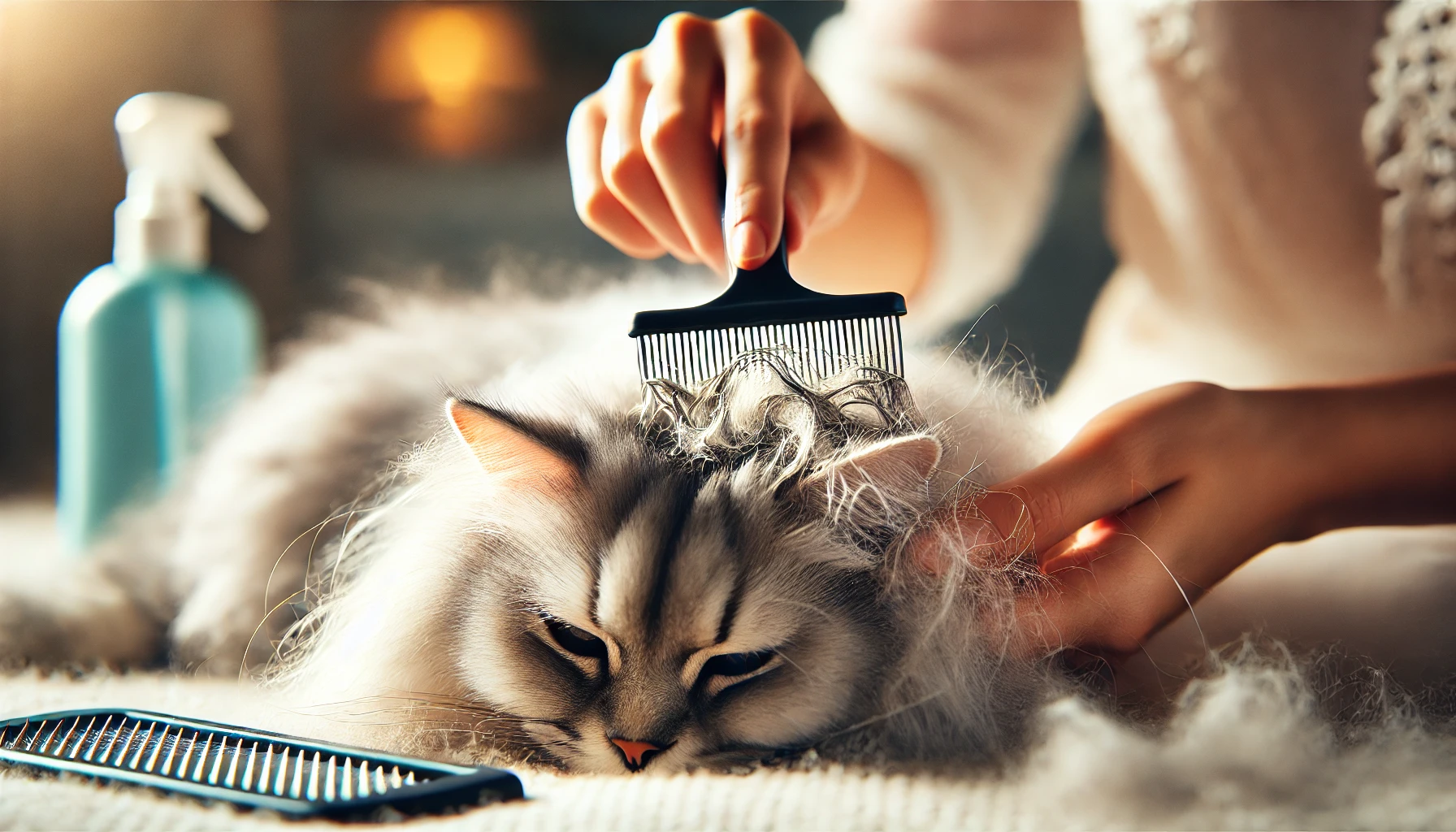
Detangling Mats and Knots Gently
Matted fur not only makes your cat uncomfortable, but it can also cause skin problems if left unaddressed.
If you find tangles or mats in your cat’s fur, you need to be delicate.
Here’s how you can detangle safely:
- Hold the fur as close to the skin as possible, as pulling directly on the skin can hurt your cat.
- Gently work the knot from the tip to the base using a wide-tooth comb or de-matting tool.
- If the mat is tough, consider using a detangling spray to loosen it, or use your fingers to gently tease the fur apart.
- Avoid using scissors, as the risk of accidentally cutting your cat’s skin is high when attempting to cut out a mat.
For cats prone to matting, regular brushing is essential to prevent knots from developing.
Consistent brushing sessions should be a part of your full grooming routine to keep your cat’s coat tangle-free and comfortable.
Regular brushing is essential for maintaining a healthy coat and preventing mats. Choose the right tools based on your cat’s coat type to make the process easier and more effective.
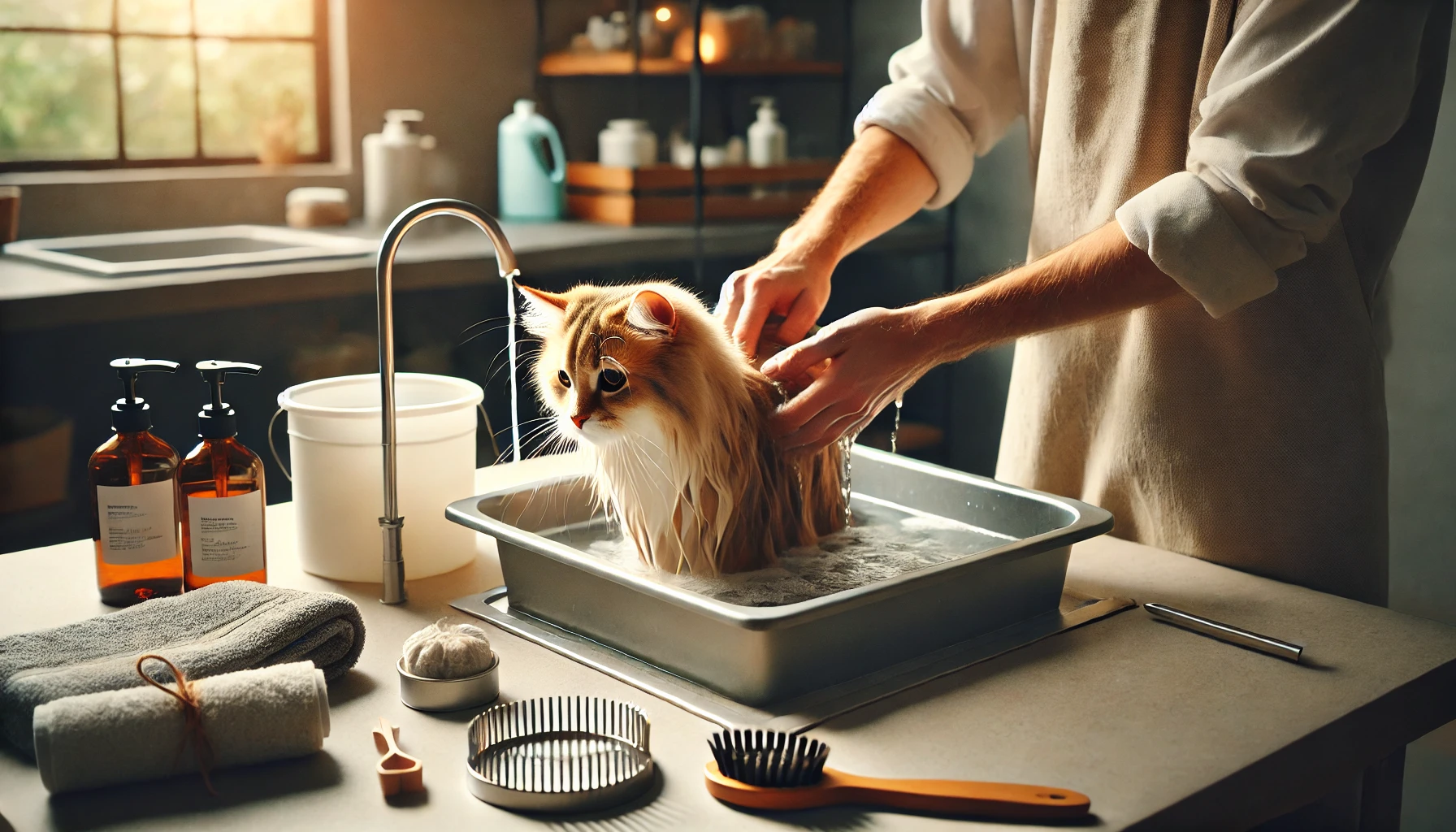
Bathing Your Cat: A Step-by-Step Guide
Not all cats like water, but some cats need to be bathed for a full grooming experience, especially if the cat is long-haired or an outdoor cat that gets dirty.
Bathing can remove dirt, oil, and allergens from your cat’s coat and help keep it clean and healthy.
The trick is to make the experience as pleasant as possible for your cat.
In this section, we will walk you through bathing your cat, ensuring comfort and safety throughout the process.
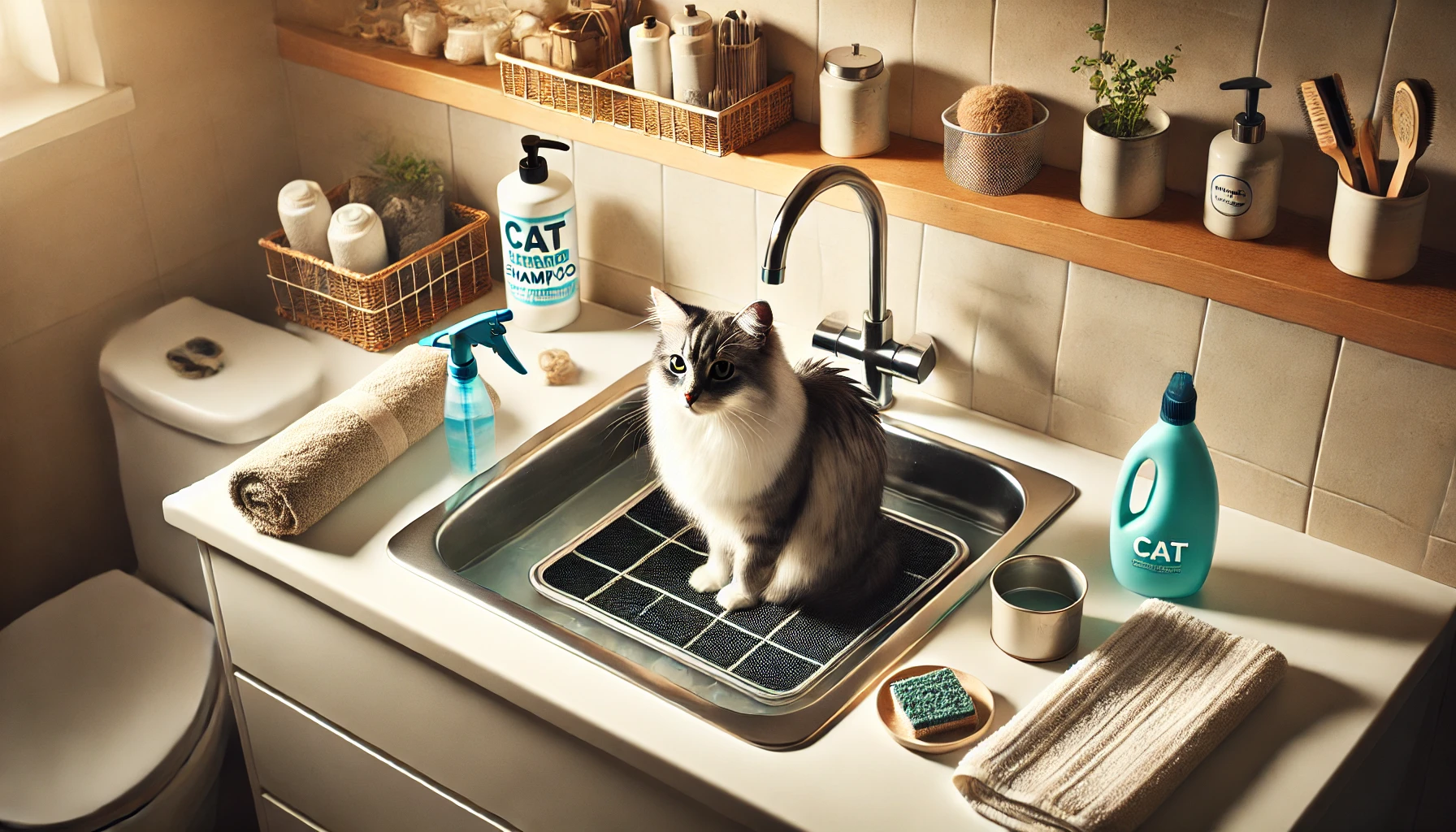
Preparing the Bath Area
Before trying to submerge your cat in water, it’s important to first prepare the bath area.
Here are some tips to help the process go smoothly:
- Choose a quiet, enclosed space: A bathroom or laundry area is ideal to minimize distractions and prevent your cat from escaping.
- Put a non-slip mat in the sink or tub: This will help your cat feel more secure by preventing them from slipping.
- Use lukewarm water: Cats have sensitive skin, so ensure the water is not too hot or too cold.
- Prepare all supplies: Have a cat-safe shampoo, cup or spray nozzle, and towels ready before starting.
Having everything ready beforehand will make the process quicker and less stressful for both you and your cat, as they will spend less time in the bath.
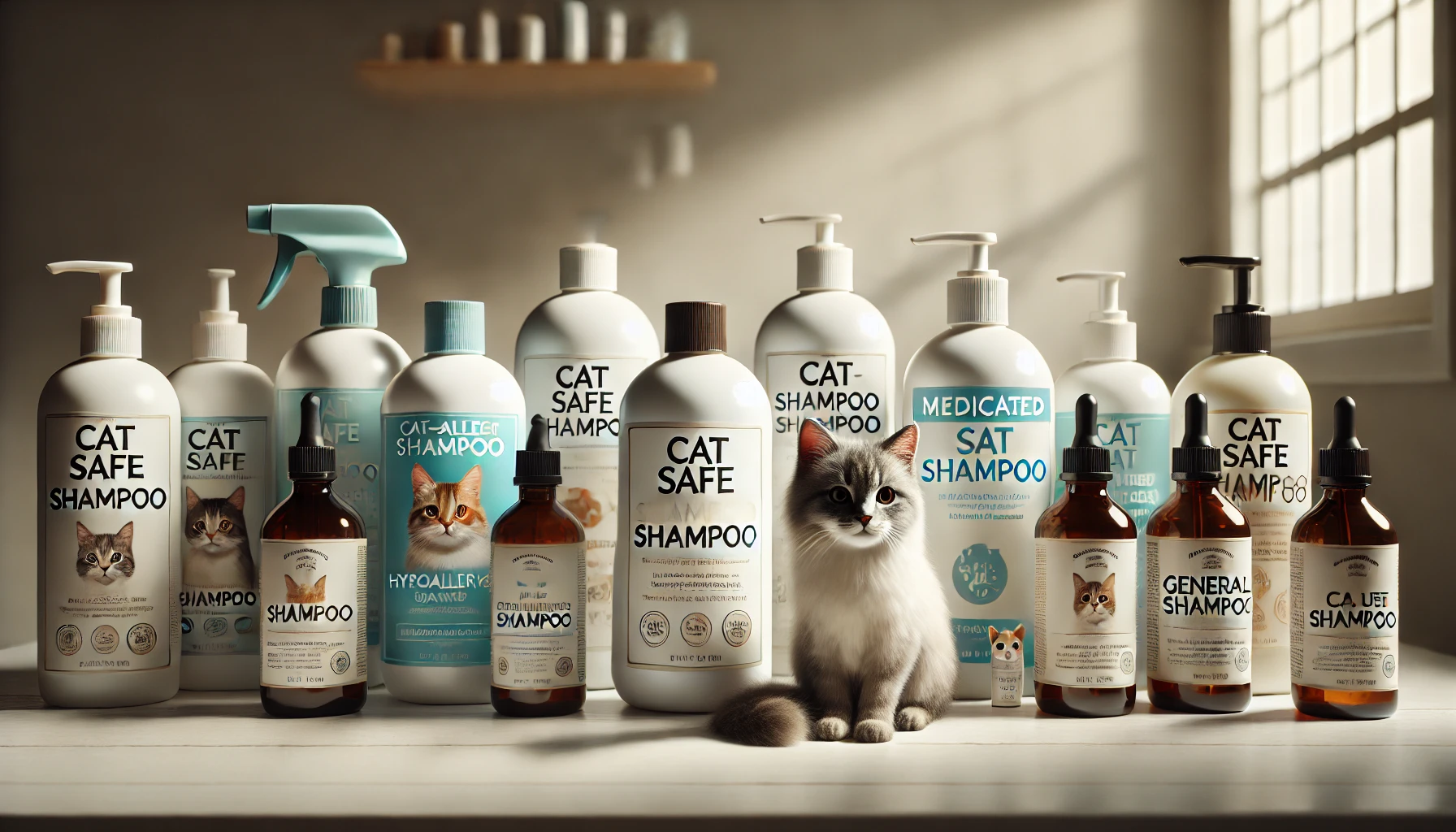
Choosing the Right Shampoo
Not all shampoos are safe for cats, so you’ll need one specifically formulated for feline skin.
Here’s what to look for in a cat-friendly shampoo:
- No harsh chemicals: Avoid shampoos with artificial fragrances, parabens, or sulfates, as these can irritate your cat’s skin.
- Hypoallergenic formula: If your cat has sensitive skin or allergies, opt for a hypoallergenic shampoo.
- Medicated shampoos: If your cat has skin conditions such as fleas, dandruff, or fungal infections, consult your vet for a medicated shampoo.
Once you have the correct shampoo, follow the instructions carefully and dilute it with water if needed, as cats have sensitive skin that can react to concentrated products.
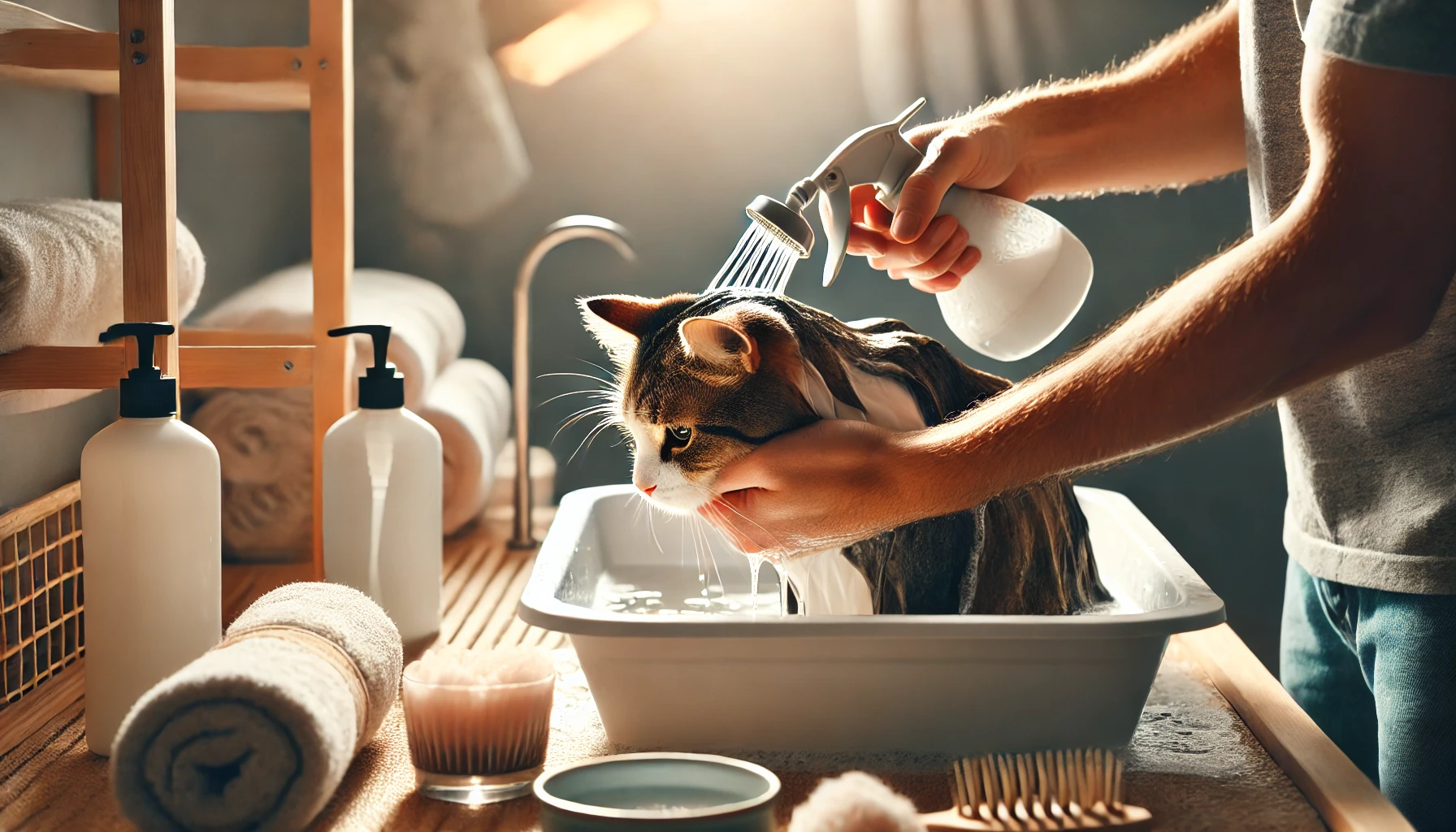
Bathing Techniques
Now that everything is ready, it’s time to bathe your cat.
Follow these steps to ensure a gentle and effective bath:
- Wet your cat’s fur: Use a cup or spray nozzle to wet your cat’s coat, avoiding the face and ears.
- Apply shampoo: Gently lather the shampoo into your cat’s fur, focusing on dirty areas like the paws and belly. Be careful to avoid the eyes and ears.
- Rinse thoroughly: Use a cup or spray nozzle to rinse off all the shampoo, as any leftover can irritate your cat’s skin.
- Dry your cat: After the bath, wrap your cat in a towel to absorb excess water. If your cat tolerates it, you can use a hairdryer on the lowest setting, but most cats prefer to air dry in a warm room.
Bathing your cat requires patience.
Some cats may tolerate it better than others, but over time, your cat should get used to this part of the full grooming routine.
While bathing can be stressful for both you and your cat, proper preparation and gentle techniques can make it a manageable and even enjoyable part of your grooming routine.
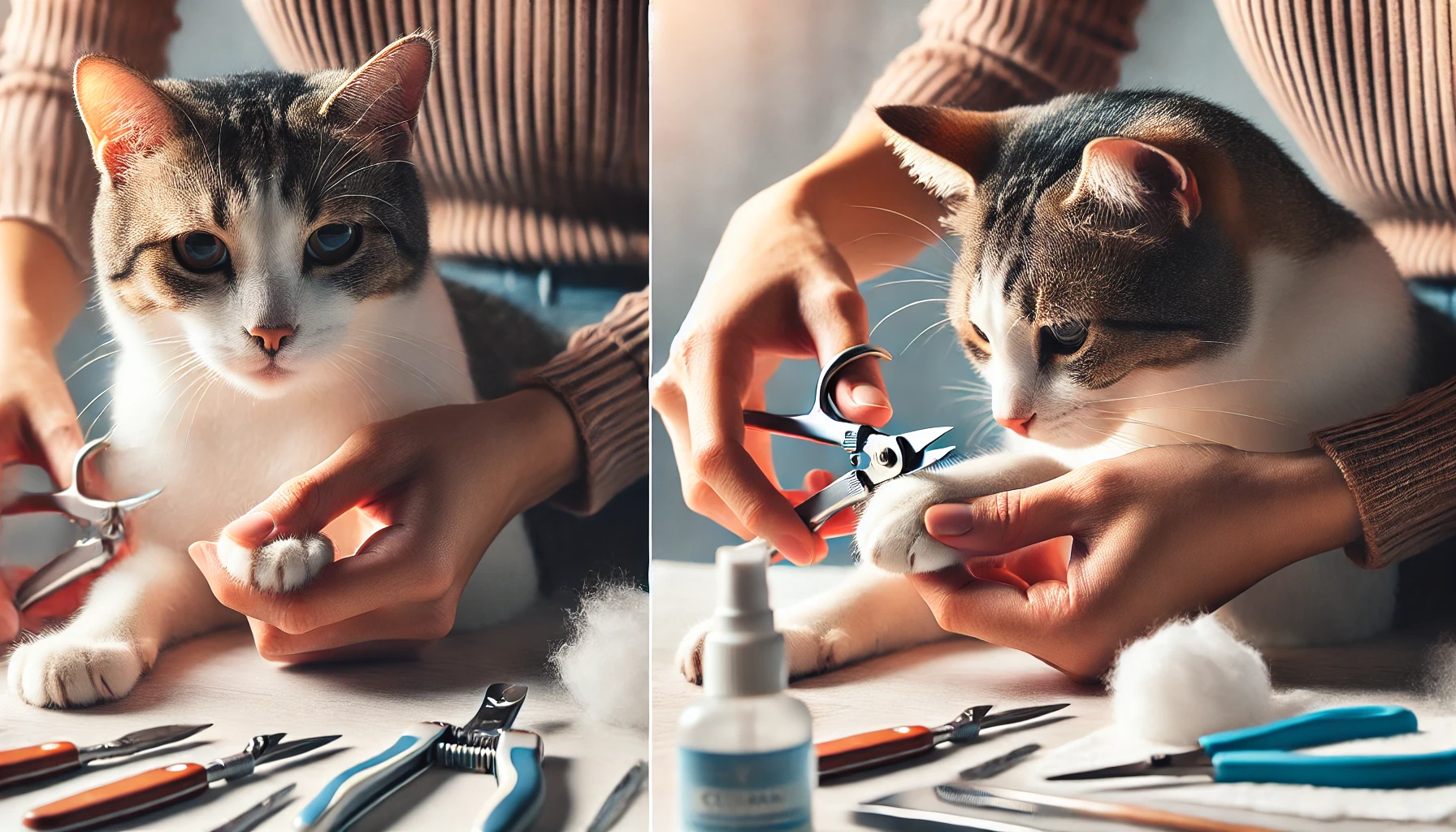
Trimming Nails and Cleaning Ears
Nail trimming and ear cleaning are part of a full grooming session that will help keep your cat happy and healthy.
Overgrown nails can be painful or even injurious, while dirty ears increase the risk of infection.
This section describes how to safely trim nails and clean ears to prevent problems from occurring in these areas.
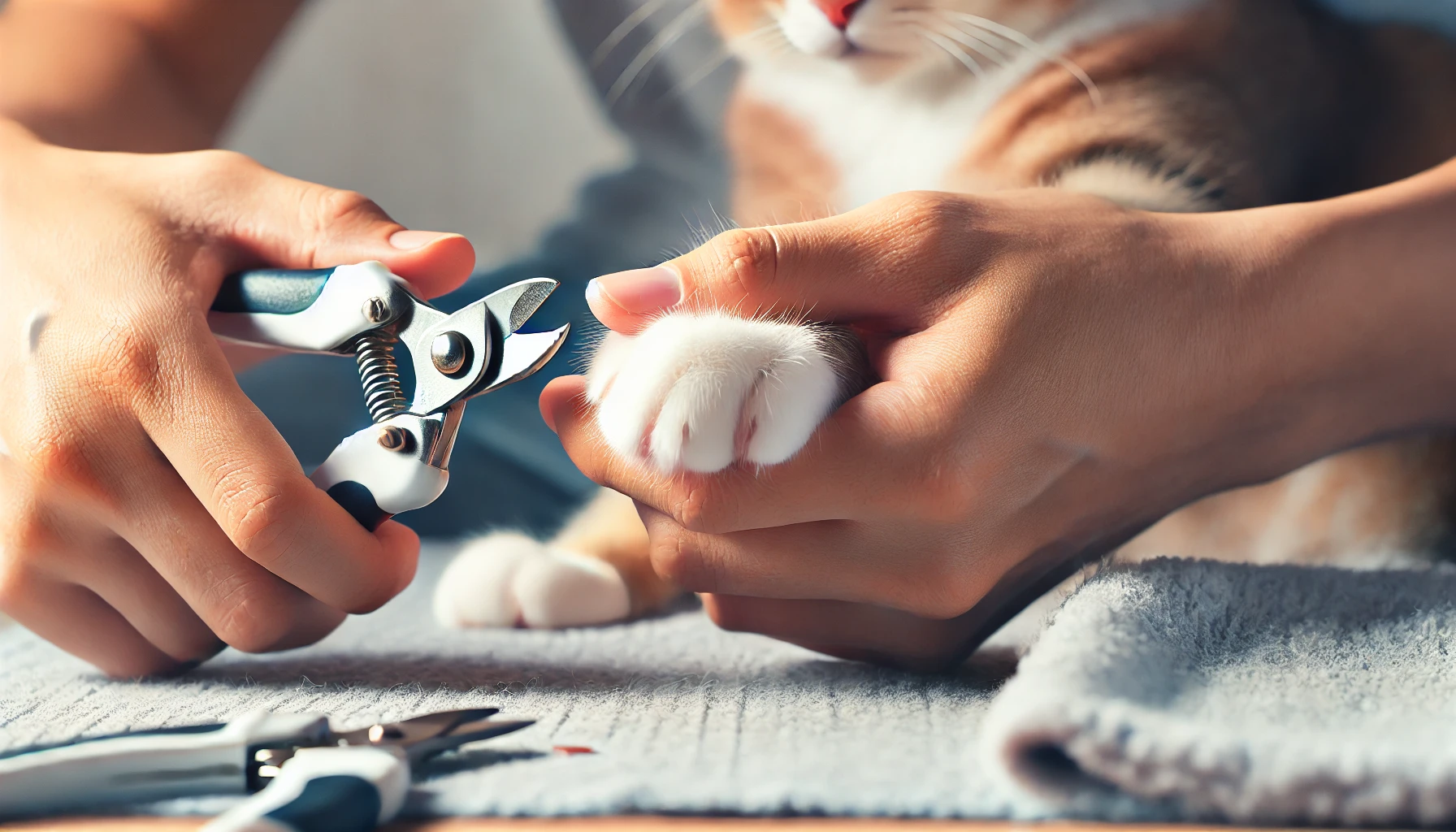
Safety Ways of Trimming Cat Nails
Clipping your cat’s nails can be sensitive for your cat, especially if they are not used to it.
Regular trims prevent claws from overgrowing or causing scratches, which is vital for your cat’s comfort.
Here’s a simplified method for safely clipping your cat’s nails:
- Choose the right equipment: Use a pair of cat-specific nail clippers or guillotine-style clippers. These tools cut the nails without turning the edges inside, which can be painful for your cat.
- Handle paws with care: Hold your cat’s paw and gently push on the pads to make the nails pop out. Go slowly with nervous cats and give them plenty of treats as positive reinforcement.
- Cut only the tip of the nail: Look for the clear part of the nail and avoid the pink area, which contains blood vessels and nerves. Cutting too close to the quick can cause pain and bleeding.
- Trim a little at a time: If your cat is fidgety, clip one or two nails at a time and take breaks as needed.
If you are unsure how to trim your cat’s nails, ask your veterinarian to demonstrate for you.
Your cat should receive regular trims to help maintain their health and comfort.
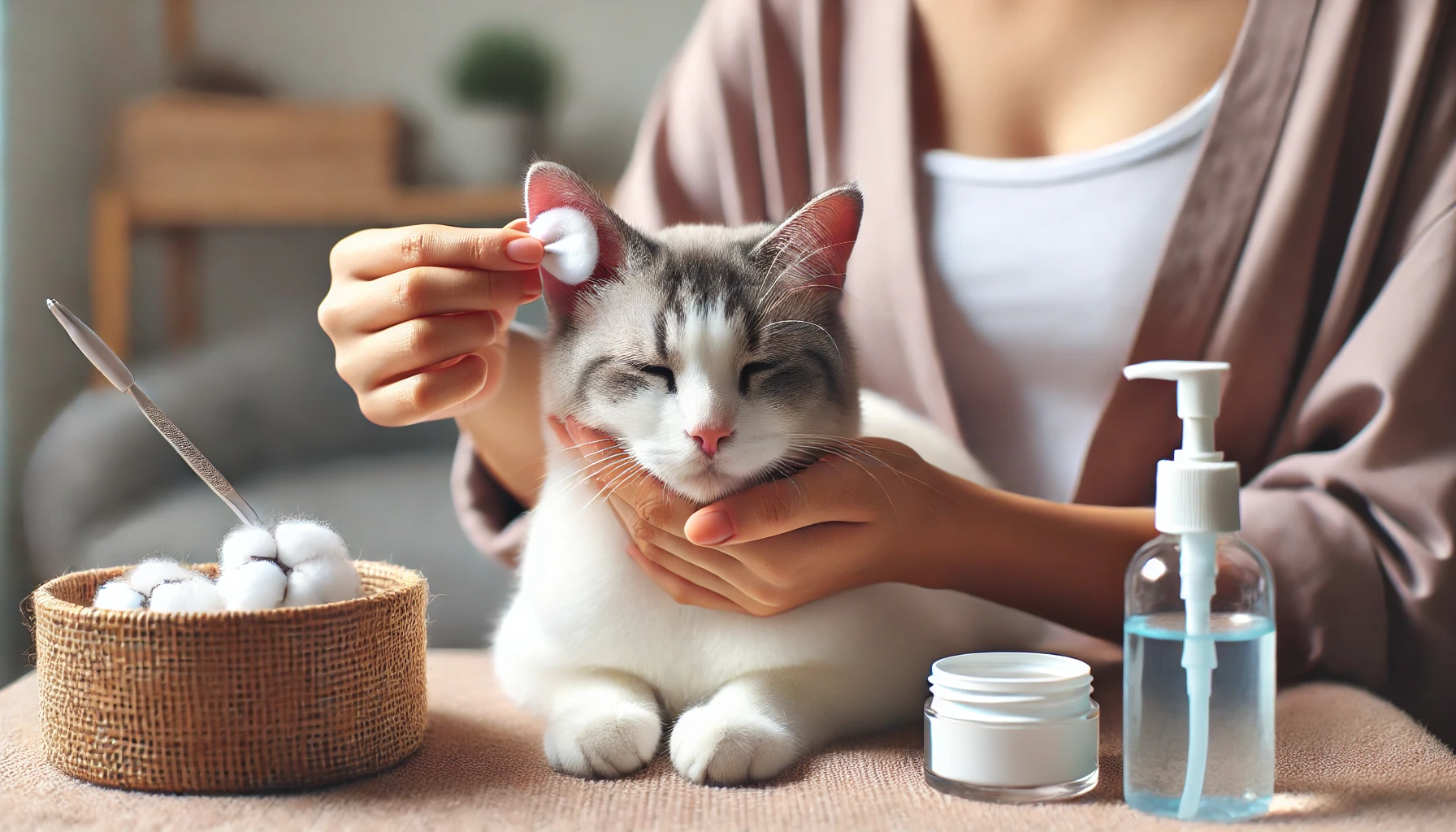
Tips for Cleaning Your Cat’s Ears
Cleaning your cat’s ears is just as important as trimming their nails.
Cats tend to suffer from ear mites, infections, and wax buildup, so it’s essential to check and clean their ears regularly.
To ensure your cat’s ears remain healthy and clean, follow these steps:
- Apply an ear cleaning solution recommended by your veterinarian: Always use products specifically designed for cats. Avoid using cotton swabs and household products like alcohol, as these can irritate the ear canal.
- Inspect the ears first: Before cleaning, check for any signs of redness, swelling, or discharge. If you notice anything unusual, contact your veterinarian before attempting any cleaning.
- Using the cleaning solution: Gently lift the ear flap and squeeze a few drops of ear cleaner into the ear canal. Massage the base of the ear to disperse the solution, then allow your cat to shake its head to remove any debris.
- Wipe away excess: Using a soft cloth or cotton ball, gently wipe away any remaining dirt and wax from the outer ear. Be careful not to push anything into the ear canal.
Regular cleaning of your cat’s ears helps to prevent infections and other ear problems.
If your cat shows signs of discomfort or you notice anything unusual, consult your veterinarian for advice.
Regular nail trims and ear cleaning are crucial for your cat’s health. Be gentle, and always use cat-specific tools to avoid injuries or discomfort.
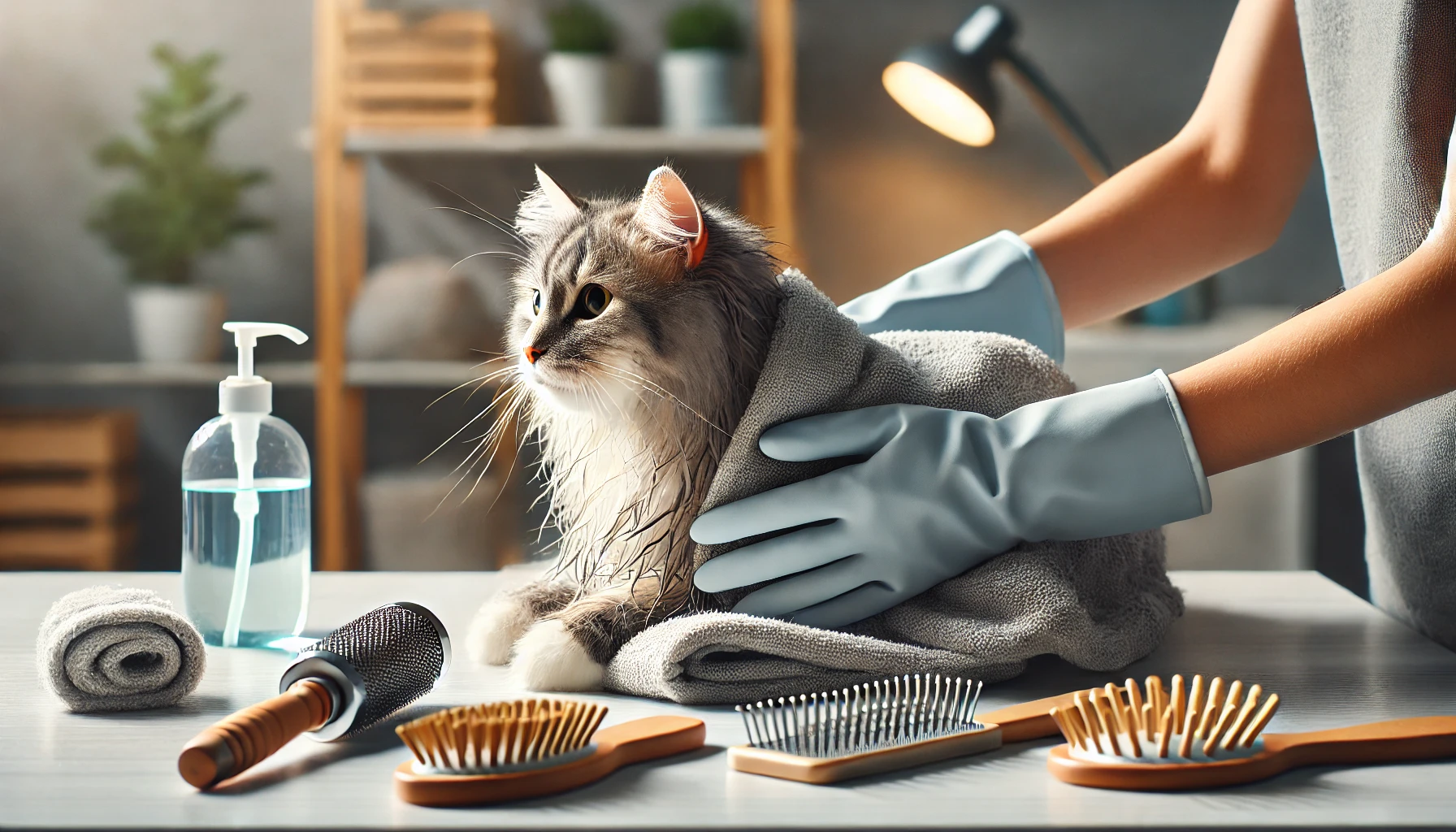
Final Touches: Drying and Grooming Your Cat after a Bath
When you have given your cat a full grooming session, which includes bathing, it becomes necessary to dry them completely and make them comfortable.
Proper drying not only prevents matting in long-haired cats but also keeps them warm and relaxed.
Brushing after bathing is essential for your cat’s coat health and shine.
Let’s take a closer look at the final touches needed in a full grooming session.
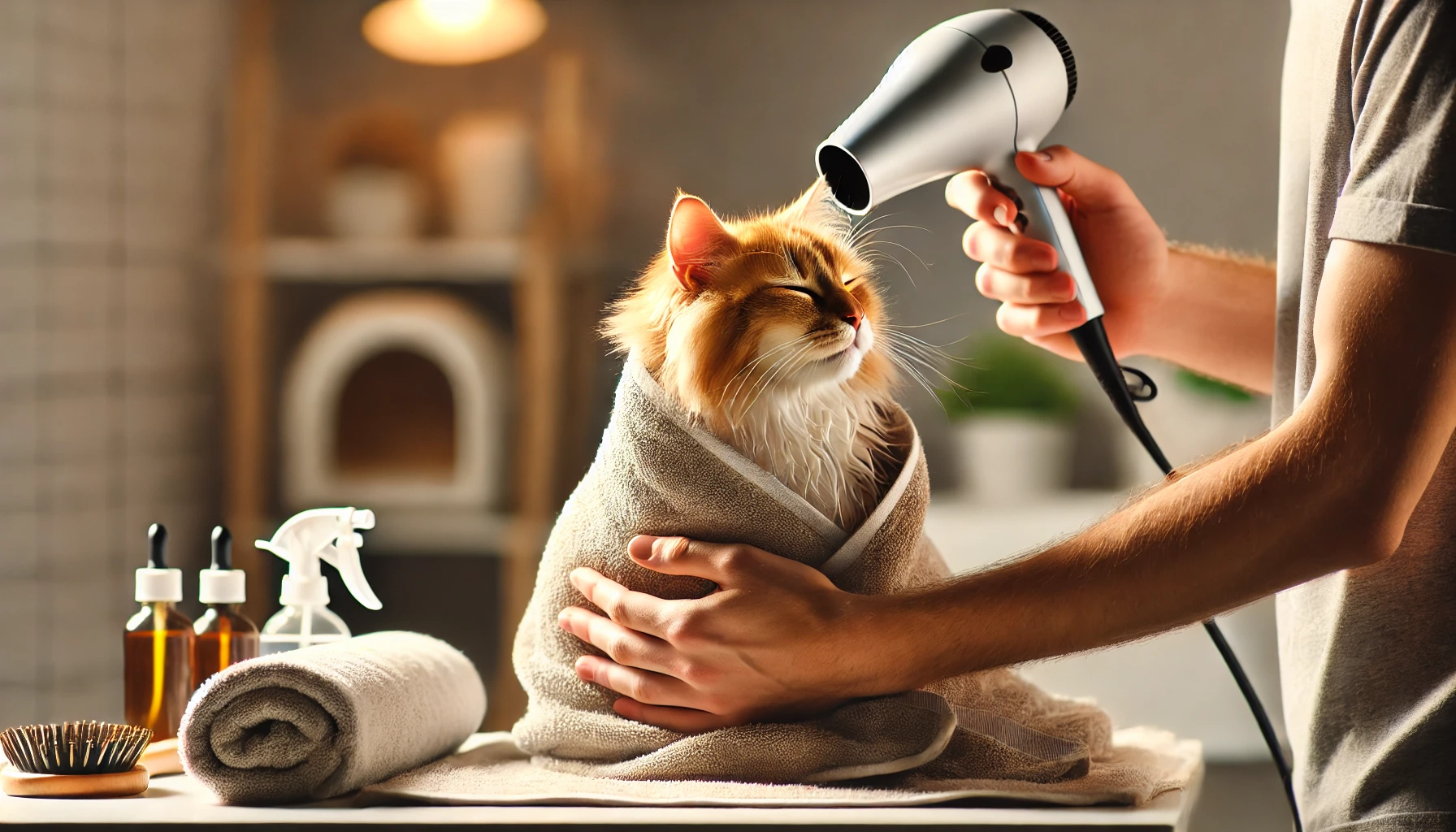
Techniques for Proper Drying
Once the bath is over, drying your cat delicately is extremely important to ensure they do not catch a cold or feel discomfort.
The following techniques can help ensure effective drying:
- Use a soft towel: Gently wrap your cat in a soft towel and blot their fur to absorb excess water. Avoid rubbing, as this can cause tangles, especially in long-haired cats.
- Air drying in a warm room: Some cats prefer to air dry. Place your cat in a warm, draft-free room and allow them to air dry. Ensure the area is quiet and free from distractions.
- Hair dryer drying (if tolerated): Some cats may tolerate a hair dryer on the lowest setting. Always use low heat and keep the dryer at a safe distance to avoid burning their sensitive skin. Test the dryer on your hand to make sure it’s not too hot.
Whether using a dryer or air drying, keep an eye on your cat for any signs of stress or discomfort during the drying process.
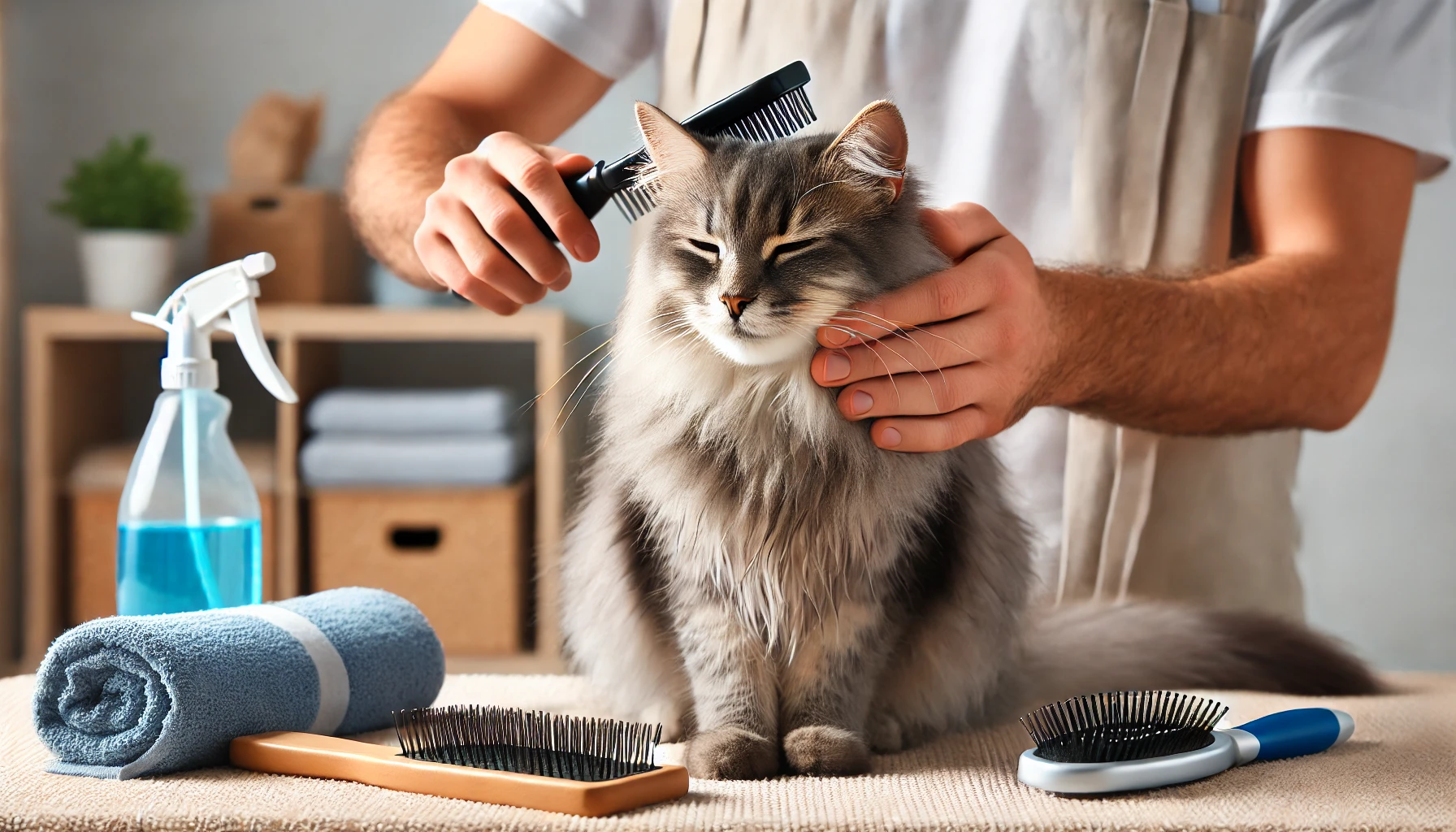
Brushing After Bathing
Once your cat is dry, brushing their coat is essential to prevent tangling and matting.
The process also helps distribute the natural oils in your cat’s skin, promoting a shiny and healthy coat.
Here’s the best way to brush your cat after a bath:
- Wide-tooth comb: Start by using a wide-tooth comb to gently work out any tangles, especially in curly-haired or long-haired cats.
- Switch to a slicker brush or bristle brush: For long-haired cats, use a slicker brush to smooth the coat and remove loose hair. For short-haired cats, a bristle brush works best.
- Be gentle on sensitive areas: Pay special attention to the belly, armpits, and tail, as these are areas where tangles are most likely to form.
Brushing after bathing will leave your cat’s coat sleek and comfortable.
Regular brushing should be part of every full grooming session to maintain a healthy coat.
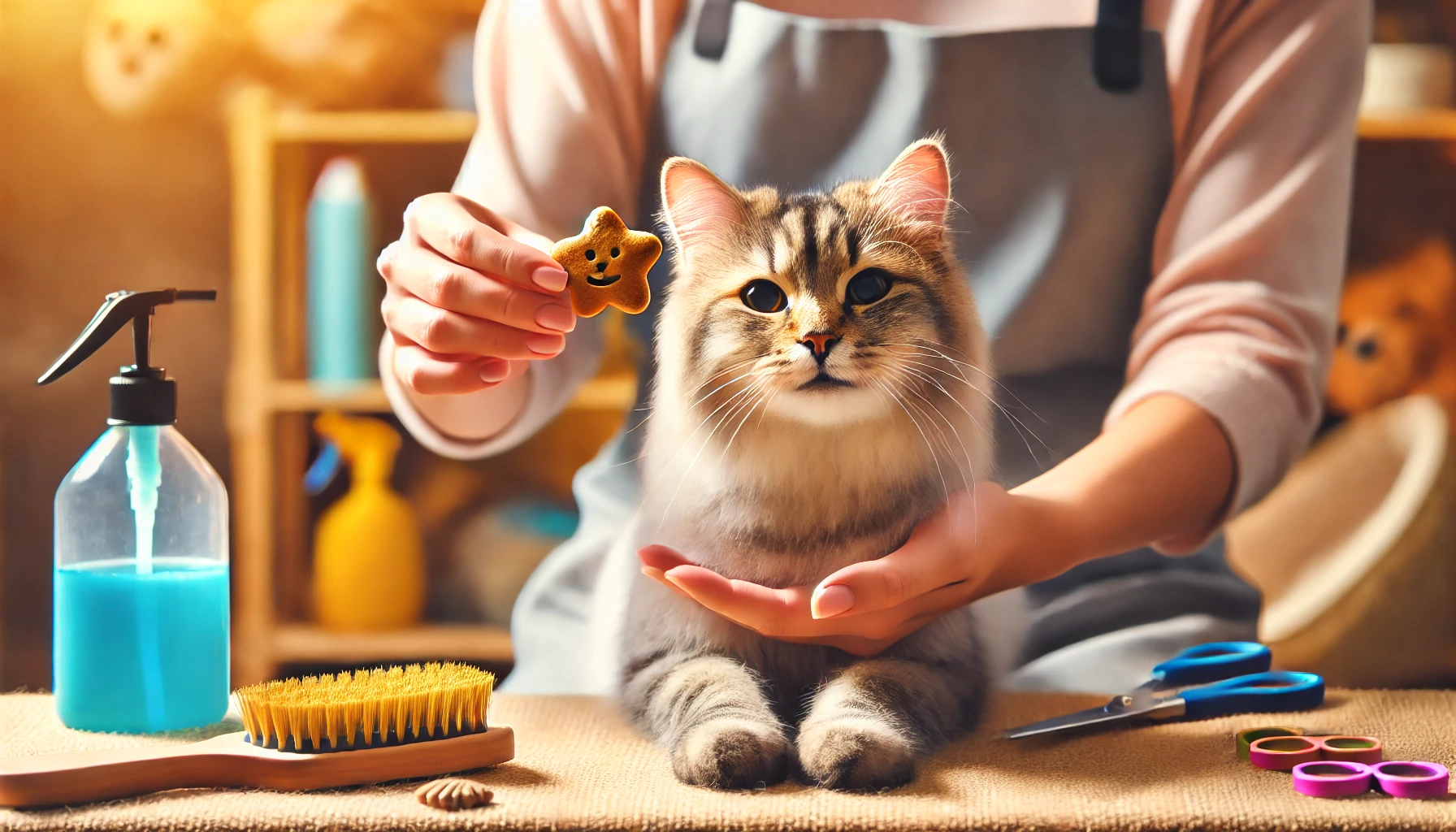
Rewarding Your Cat for Cooperation
For some cats, grooming can be a stressful experience, so it’s important to reward their cooperation with positive reinforcement.
Rewarding your cat after the grooming session with treats, petting, or playtime will help them associate grooming with positive feelings.
- Treat them with their favorite snacks: Give your cat their favorite treat to help them learn that grooming is a good experience.
- Petting and praise: Gently pet and praise your cat to help them relax after grooming. This may make them more tolerant of future grooming sessions.
- Playtime: Some cats enjoy playtime after grooming. Engaging in a fun activity with them can help release any residual stress.
By rewarding your cat, you’re helping to associate grooming with positive experiences, making future sessions smoother and less stressful for both of you.
After a bath, proper drying and brushing ensure that your cat’s coat stays healthy and mat-free. Take your time and reward your cat for their patience.
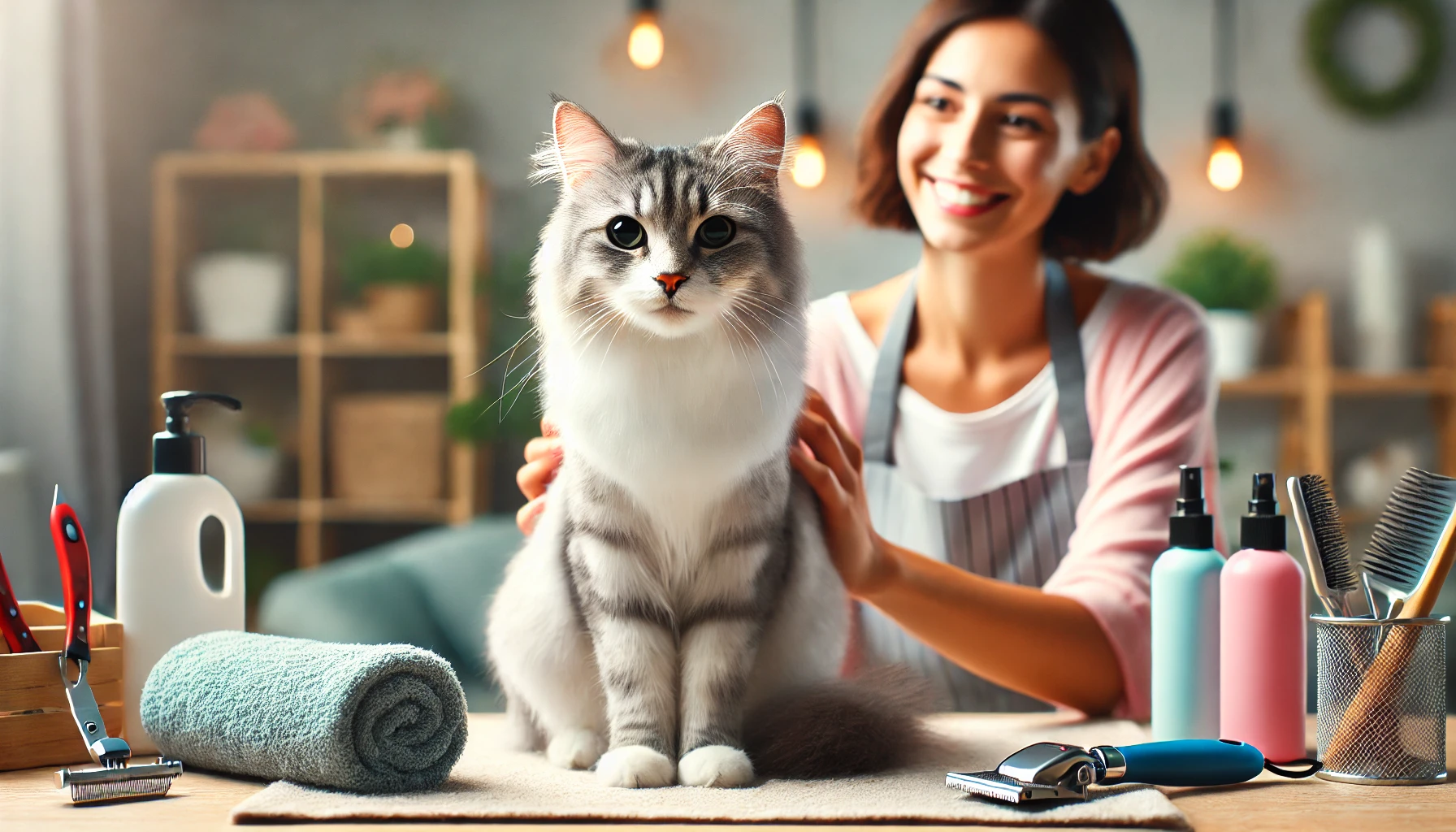
Conclusion: Mastering a Full Grooming Session for Your Cat at Home
A full grooming session for your cat involves much more than maintaining their outward appearance; it plays a critical role in their overall health and well-being.
From preparing your cat for grooming to mastering the art of brushing, bathing, nail trimming, and ear cleaning, each step contributes to making your feline friend comfortable and happy.
While it might seem overwhelming the first time, with patience and the right equipment, grooming can become a smooth and pleasant experience for both you and your cat.
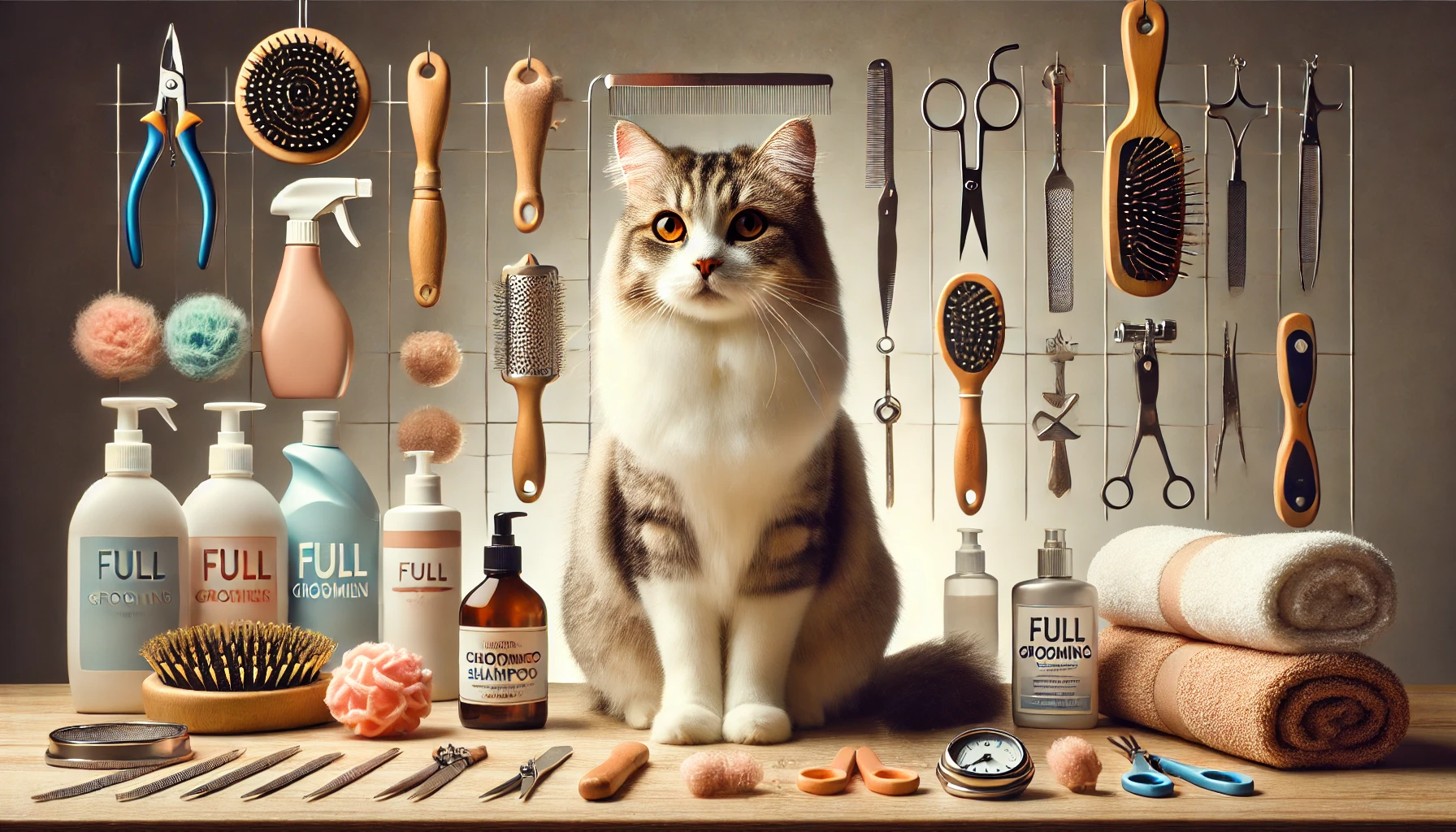
Key Takeaways for a Successful Full Grooming Session
Each part of the grooming session is important for your cat’s coat maintenance and overall health.
Here’s a quick rundown of the key steps:
- Preparation: Gather the right equipment and prepare a quiet, distraction-free area to ensure a stress-free experience for your cat.
- Brushing and Detangling: Regular brushing prevents mats, maintains a healthy coat, and spreads natural oils across your cat’s fur.
- Bathing: Be delicate during bathing. Use lukewarm water and cat-specific shampoo, and take the time to dry your cat properly to avoid discomfort or illness.
- Nail Trimming and Ear Cleaning: Regular nail trimming and ear cleaning prevent discomfort and health issues, ensuring your cat stays in top condition.
- Final Touches: Brushing after bathing enhances your cat’s coat shine, while rewarding your cat makes future grooming sessions easier to conduct.
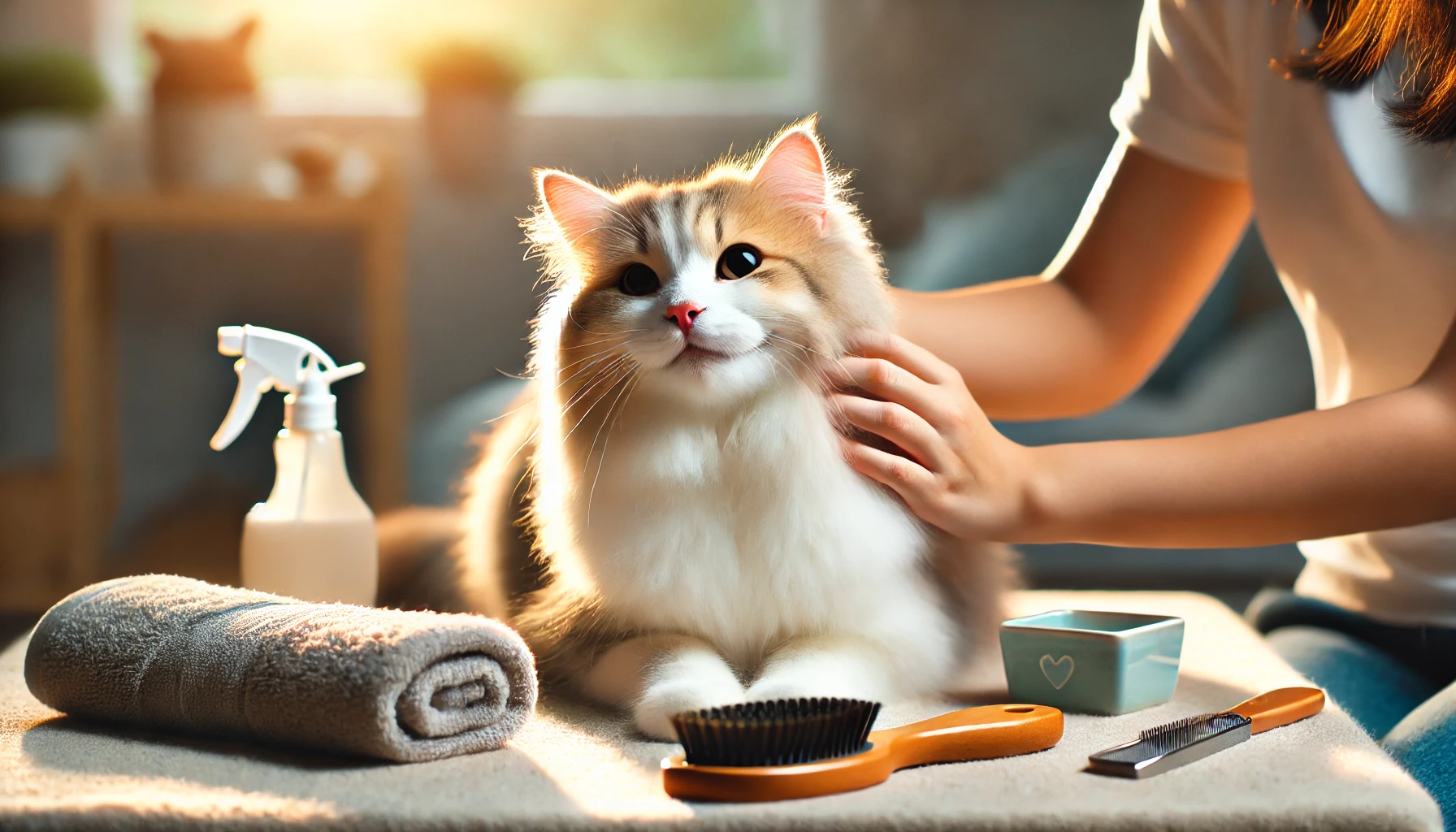
Making Grooming a Positive Experience
To make full grooming sessions a positive experience for your cat, it’s crucial to create a comfortable environment and handle them with care.
Reward your cat with treats or praise during and after grooming to reinforce good behavior and keep the experience as stress-free as possible.
Over time, your cat will learn that grooming sessions can be enjoyable, making the process easier for both of you.
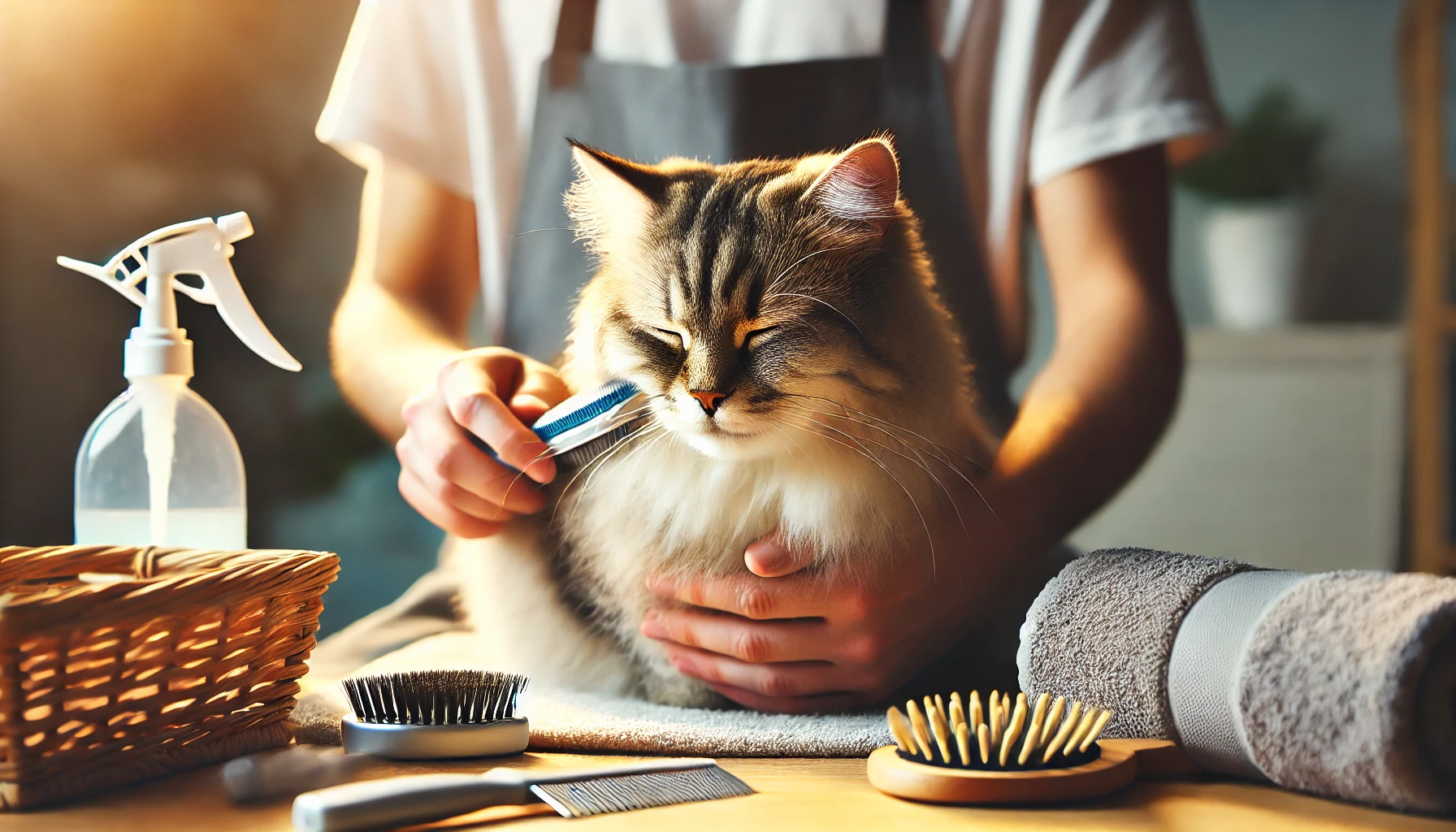
Consistency is Key
As with many aspects of pet care, consistency is key to a successful full grooming routine.
Regular grooming sessions help you stay ahead of your cat’s health, prevent matting, and keep their coat in excellent condition.
Establishing a consistent grooming routine will help build trust, reduce anxiety, and make the process faster and easier each time.
By following this step-by-step guide, you’ll be able to conduct a full grooming session with ease from the comfort of your home.
Your cat will look and feel great, and the process will strengthen the bond between you and your feline companion.
Consistency and patience are key to mastering at-home grooming. With practice, both you and your cat can enjoy a stress-free grooming routine that promotes health and bonding.
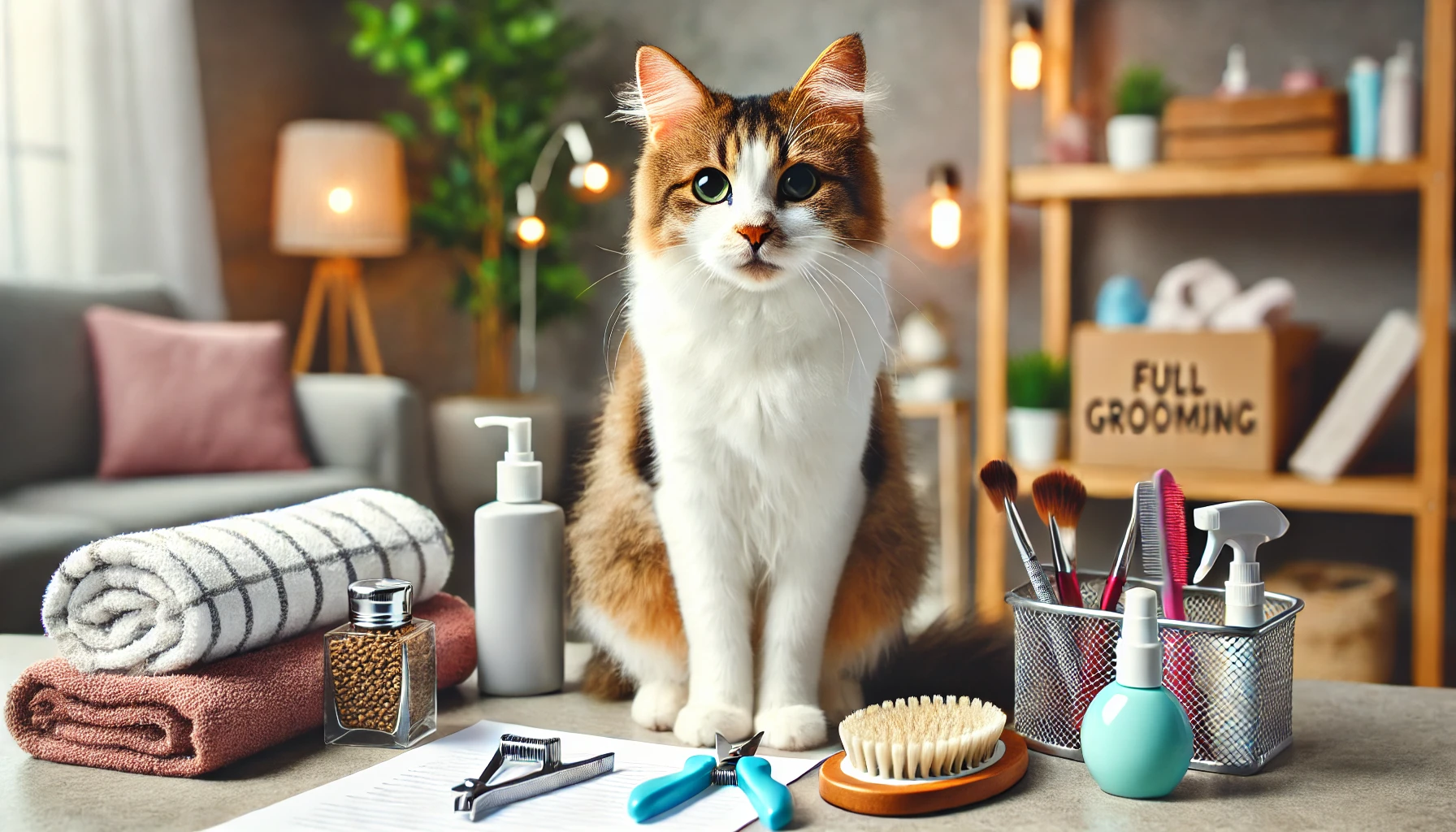
Frequently Asked Questions About Full Grooming for Cats
Below are answers to some of the most frequently asked questions about full grooming sessions for cats.
These will help you understand common concerns and provide guidance to ensure your cat has a smooth grooming experience.
How often should I give my cat a full grooming session?
The frequency depends on your cat’s breed and coat type.
Long-haired cats may need full grooming every few weeks, while most short-haired cats can be groomed once a month.
What is the best way to relax my cat before grooming?
Set up a quiet environment and provide some light petting before grooming.
Reward your cat with treats and repetition so they can associate grooming with a positive experience.
My cat hates being bathed—what should I do?
If your cat dislikes baths, consider using alternatives like dry shampoos or wipes.
Bathe them less frequently and gradually help them become accustomed to water using positive reinforcement with rewards and treats.
Is it safe to use human shampoo on my cat?
No, human shampoo is too harsh for cats and can irritate their skin or cause allergic reactions.
It’s best to use a shampoo specifically formulated for feline skin.
How will I know if my cat's nails need trimming?
If you hear clicking sounds when your cat walks or notice their claws catching in fabric, it’s time for a nail trim.
Long nails can cause discomfort and increase the risk of injury.
How do I prevent mats from forming in my cat's fur?
Regular brushing is the best way to prevent mats.
For long-haired cats, brush them a few times a week, paying extra attention to sensitive areas like the belly and armpits.
How can I get my cat used to regular grooming sessions?
Introduce grooming gradually with short sessions.
Reward good behavior with treats and praise, and over time, your cat will become more comfortable with regular grooming sessions.
Can I use a hair dryer to dry my cat after a bath?
Yes, you can use a hair dryer on a low heat setting if your cat tolerates it.
Keep the dryer at a safe distance and monitor your cat’s comfort during the drying process.
When should I seek professional grooming services?
If your cat has severely matted fur, behavioral issues during grooming, or health problems that complicate grooming, professional services can help avoid injury or stress.

